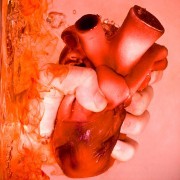 Photo: Getty Images
Photo: Getty Images
The onset of chest pain can be a symptom of many different conditions, both cardiac and non-cardiac. Angina is a group of conditions characterized by chest pain as the result of decreased oxygen supply to cardiac muscle. Patients experiencing angina will feel a tightness or pressure across the chest, which can radiate to the jaw, teeth, neck, arms, or back.
These patients will not experience increased pain upon palpation of the chest or application of pressure to the chest. Angina can be a serious condition, as it can indicate the presence of other underlying heart conditions.
There are several types of angina: stable angina, unstable angina, variant (or Prinzmetal’s) angina, and microvascular. Stable angina, the most common type, occurs on a regular basis as the result of decreased oxygen supply to the cardiac muscle. The onset of symptoms is caused by an increase in cardiac strain, possibly from exercise, emotional stress, large meals, or sudden exposure to cold weather. The symptoms last between 1-15 minutes on average and can be relieved through the use of nitroglycerine or rest. In some individuals, stable angina can indicate an increased risk of a heart attack.
Unstable angina is the irregular onset of chest pain, which can be more severe than stable angina. Unstable angina can occur regardless of increased cardiac output, and may not respond to medication. While unstable angina is not a heart attack, the erratic episodes indicate possible cardiac compromise. Unstable angina can be a precursor of heart attack.
Variant angina is a rare form of angina, which can be more severe than other forms. Variant angina is caused by spasms in a coronary artery, leading to reduced blood flow. This particular form of angina is more common in younger individuals. The onset of variant angina is typically between midnight and early morning. ) Nitroglycerine will generally relieve the symptoms of variant angina.
Microvascular angina is a more serious form of angina, which can indicate coronary microvascular disease. The pain experienced in microvascular angina can last much longer than other forms of angina, and may not respond to rest or nitroglycerine. Microvascular angina does not typically occur as the result of exertion, and the exact causes can be multi-factorial.
Any form of angina can indicate the possibility of other cardiac issues, with coronary heart disease being commonly linked to angina. Individuals experiencing angina should contact a medical professional to rule out the possibility of further cardiac disorders.
References:
1) http://www.medicinenet.com/angina/article.htm
2) http://www.nhlbi.nih.gov/health/dci/Diseases/Angina/Angina_WhatIs.html
3) http://emedicine.medscape.com/article/150215-overview





Add a CommentComments
There are no comments yet. Be the first one and get the conversation started!